Targeting Informational Search Intent
In 2016, a client had the need to increase more traffic to their blog. The following post is a window of insight into the process of what I think is targeting informational search intent:
– Coming up with an article topic, considering the sales funnel and keyword research
– Analyzing opportunity in the search results
– Considering how to format the post given the structure and detail of presently-ranking URLs
This article is useful for:
- Those who form editorial calendars in-house or for clients
- Copywriters who want to write keyword-focused content
- Anyone curious about my process of creating content for blog posts
Targeting Informational Search Intent …
We start with a goal of targeting informational search intent queries and seizing opportunity. The client seeks to add traffic and sales to a website via keyword-focused and well-ranking blog posts. I breakdown the goal into small tasks:
- Find an informational topic
- Consider the topic in the sales funnel
- Identify a key term
- Consider key term volume, relevance, and competition
- Evaluate presently ranking content
- Dissect on-page SEO and layout
- Suggest a blog topic to place on client site
Types of Search Intent
Search intent is important, for it will sculpt the shape and layout of search results. Also, as discussed below, it provides a window into the logic or psychology of the searcher. For now, let’s focus on these categories of search intent:
- Informational – a searcher wants to know something
- Navigational – a searcher wants to get to a specific website, such as Facebook or use a tool like Google Analytics
- Transactional – a searcher wants to make a purchase
- Commercial Investigation – a searcher is looking to make an eventual purchase
These have been evaluated and reevaluated, but for the sake of this article, these categories of search intent work well as I’m solely focused on informational search intent.
Find an Informational Search Intent Topic
Our target reader is not signaling transactional intent. They are not ready to buy. They want to know. I learned pretty much all I know about keyword research from Dan Shure. I recommend watching this to better understand user intent to create content that drives traffic.
Link Informational Search Intent Topic with the Sales Funnel
The client offers sales recruiting services, and sales managers comprise a large part of the target market. There’s a structured process in finding informational keyword opportunities, but I like the idea of inserting art and creativity too. Marty Weintraub is some sort of marketing alien-genius.
I want to ‘get in the head’ of a sales manager. Marty Weintraub is the source for this kind of psychographic information and train of thought.
We consider the stages of the sales funnel to define a correlation between the target and the client’s services, for this dynamic will inform selected keywords and angle of content development.
Awareness > Interest > Consideration > Intent > Evaluation > Purchase
The client offers sales recruiting. The target reader will be sales managers. What is the dynamic between a sales manager’s needs and the client’s offered services?
A sales manager needs sales recruiting when:
- developing a new team
- supplementing an existing team
- lacking in-house resources to qualify candidates
- failing to get results
More reasons exist, but it’s necessary to start thinking this way to properly calibrate informational content opportunity. The content seeks to satisfy a need of the reader and move them along the sales funnel, closer to a purchase.
What are the concerns of sales managers in the awareness and interest phase, those at the top of the funnel for sales recruiting services?
- figuring how to manage remote employees
- getting necessary equipment
- establishing KPIs
- getting more funding for their department
Potential angles for articles could be:
- how to manage a sales team
- best sales team equipment
- sales team KPI template
- getting the CFO to buy-in
At this stage of the funnel, a sales manager is attempting to articulate their problems, so their searches may be related to the ‘symptoms.’
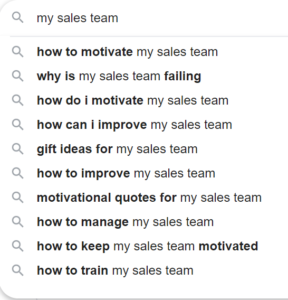
This is applicable to other varieties of service providers. If my client were a bookkeeper, I might consider the problems a small business owner, their target market, has not fully realized.
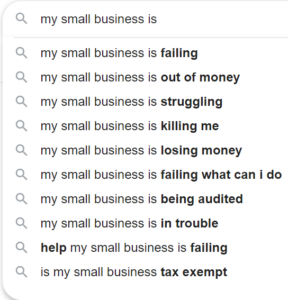
A bookkeeper can address those concerns and solve related problems. An article angle such as, “Does My Small Business Need a Bookkeeper” intrigues small business owners in the interest phase of the funnel, those who would conduct such a search.
Tweaking the title may widen the scope and initiate the sales funnel for a reader who otherwise would not have articulated their problem or thought of a seeking a solution. Consider the heading, “7 Reasons Your Accounting Is Running You Out of Business.”
There’s little hope of long-tail targeting with that long-winded title, but it does create a sense of urgency from a copy perspective. Bring the reader’s attention to problem X that will result in Y…. unless Z (the provided solution). This is a CopyBlogger sales page tactic.
In this example:
X = the problem = lack of confidence in accounting
Y = impending doom = competitors hiring top talent, missing windows of opportunity, going out of business, etc.
Z = the solution = the body of the content, highlighting how the a bookkeeper can address X
In the discovery phase, the client can’t quite name their problem. That’s why we eventually do it for them by first analyzing their ‘symptoms.’
Find the Right Informational Keyword or Phrase
Considering the sales team ‘symptoms’ above, motivation seems to be a topic of interest and concern. We start researching ways to motivate a team to find an informational search query.
Many things motivate individual members but nothing about the team as a whole… Wait ‘a team as a whole’…what enforces a sense of team?
We keep dabbling.
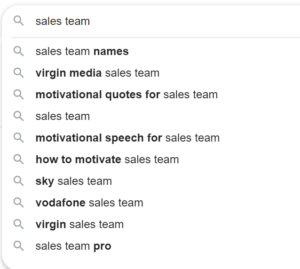
This is the Marty way. We’re getting in the head of our targeted reader. It’s also useful to detour toward a tool-focused route once you’re ‘in the head of the target.’
We put “sales team” in SEMrush. The keyword overview tells us 1.3k questions relate to the head term.
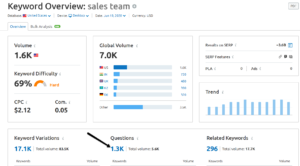
We take interest in key terms in the form of questions given this is an informational intent quest. However, ciphering through 1.3k questions is a lot of work. This is when we layer in the consideration of volume, relevance, and competition level.
Consider Keyword Volume, Relevance, and Competition Level
We need to find that bull’s eye regarding a key term’s search volume, relevance, and competition level.
Keyword Volume
Keywords with high search volumes are tempting but can be dangerous without a clearer sense of situational awareness.
For example, consider we rank in a top spot for a term that gets 10 searches a month, but there’s a very high click-to-sales ratio and we’re selling private jets for $5 million. In this case, 120 opportunities per year to make $5 million from hosting a piece of copy sounds really appealing, eh?
In short, considering volume requires further strategy and layering in other factors such as intent and relevance is necessary. Nick Eubanks highlights his take on volume in his Keyword Strategy Guide.
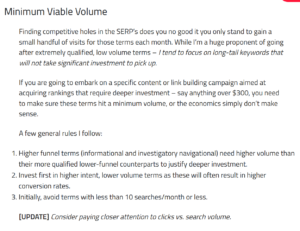
Keyword Relevance
Nick’s update regarding clicks versus search volume hits upon relevance. Let’s assume a key term has high volume but misleads us.
A Case of Misinterpretation
Consider a piece of content gets thousands of visits per month because it addresses a common technical software problem. Our client sells that same software and updated editions of it. It was initially thought a great ‘win,’ yet that content is not leading to other page visits or converting to sales.
It could be due to misinterpreted intent and relevance; maybe the visitor just needs information and already has the software. Moreover, maybe we find upon further study that people are more likely to buy the updated editions from a main supplier versus a reseller. Our content is heavily visited but it’s not helping the client sell.
Pondering relevance is another time to put your Marty hat on and ask, “What would my target audience do?”
Relevance as Reflected in the SERs
It’s addressed in a later section, but you need to consider relevance in relation to the SERs. A key term may seem incredibly relevant yet the alignment of the SERs ( sales pages and blog posts in SERs signal Google’s confusion of intent) tells another story. This is especially true if a generic term has been related with a now-branded term. (Marty talks about this in an Experts on the Wire podcast. Find out how a realtor can claim “lakefront property.”)
Keyword Competition Level
Let’s go back and evaluate the 1.3k questions SEMrush delivers related to the head term, “sales team.” To start, it may be useful to fine-tune. In the ‘keyword magic’ section, take note of how terms are grouped on the left by number or volume.
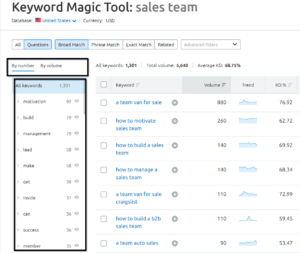
For example, we can parse-out the ‘motivation’ group, which is the subcategory with the highest number of keywords. Furthermore, at this point, we probably have a sense of your client’s authority and ability to rank. In this case, our client’s site had lower authority, so we use advanced filters to regulate the competition level.

We don’t like my choices within the motivational subgroup. So, we go back to look at questions regardless of sub group, but within the competition level of 70-75. We don’t like the looks of things here either. It’s okay — it made sense to look into the motivation subgroup.
Now, we need to pivot. I’m not finding any good topics with some search volume. Maybe we’ll find something if we take a step back and view all keywords related to the head term while still using the advanced filter to calibrate the level of competition.
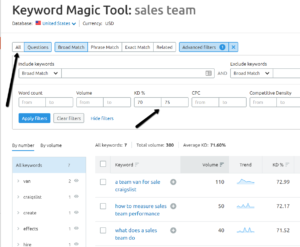
Houston, we’ve found something.
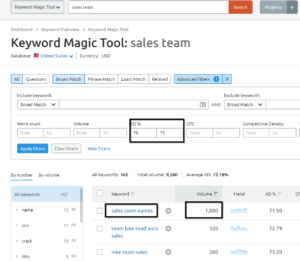
It’s close to a bull’s eye. It has 1k search volume. It’s relevant; a sales manager looking to motivate a sales team may do so in part by naming the team.
Furthermore, grabbing the attention of a sales manager who is looking to name their team is a good sales funnel fit regarding the client’s offered services of sales recruiting. Lastly, we’ve calibrated for the right window of opportunity regarding keyword difficulty. Now, we dissect the SERs for that term and top-ranking content.
Evaluate Search Engine Results for Keyword or Phrase
To start, we want to ensure my assumption related to the key term is reflected in Google’s results. By searching “sales team names,” we assume we’re met with informational results in the form of pieces of text that literally list names.
This is what the bulk of the pack looks like when searching the term.
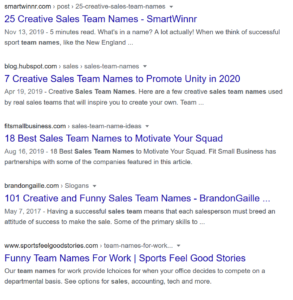
Assumptions are validated. It appears most results are lists, as if the searcher has a sales team and seeks ideas for a name. Or, someone is generally curious about team names, yet the ‘sales’ part qualifies the traffic a bit more versus someone who just wants to know clever team names.
Some things to consider when evaluating the SERs:
- Opportunity for snippet
- Structure of titles (numbers, adjectives, etc)
- Domain Authority (debatable)
- Number of Domain Links
- Number of Page Links
- Date of Publish
- Other formats (video, podcast, recipe)
- ‘People Also Ask’ box
- Related search suggestions
It’s fun to debate on what is more important, but I think it’s situational and how each is weighted may vary depending on search intent, whether it’s product or service related, the types of content that serve the query, etc. In this scenario, let’s assume the client’s chances of ranking looks good. At this point, we want to survey the position 0 and 1 selection further.
Dissect Each Page
Dissect each page, looking at on-page SEO metrics as well as the general-to-specific layout.
On-Page SEO
Here are some on-page SEO element to consider if we want to evaluate each URL in the results.
Again, the weight of each is situational. For example, we could unnecessarily fixate on the number of words on the page because we know Google promotes the best answer, regardless of word count. So it shouldn’t matter… and EMDs don’t rank (wink).
We use SEO Minion to analyze the page currently in position 0. Let’s take a look at meta tags and alt tags for presence of key terms and H tags, for they may inform how to outline a competing piece of content.
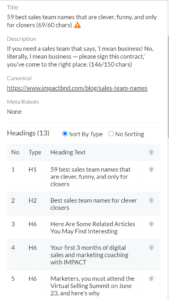
In this case, H tags aren’t going to get my attention, but a lot of times they do. I think it’s very handy when structuring an outline if you intend to compete for a key term that necessitates more structure, like a how-to.
“How to build a skate ramp” may not be the best example because you can argue that a video is a better source of information, but for the sake of seeing H-tag structure, let’s consider a text-heavy piece of content ranking on the first page for the result.
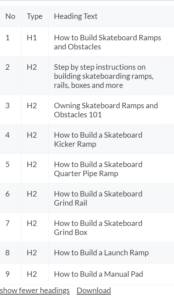
If I were targeting the key term, I would be very attentive to the H-tag structure of well-ranking pages.
Let’s check for patterns related to the number of internal links and outbound links.
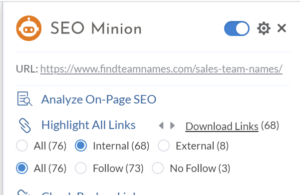
Layout
The first two results for “sales team names” lead to articles that literally list names in a vertical pattern.
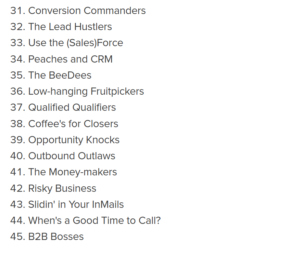
The article in position one complements the names with pithy descriptions or characteristics.
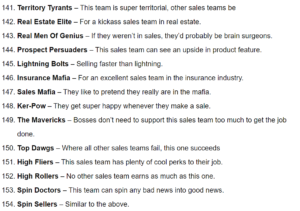
The position two article features names and logos, along with a vote option at the bottom.
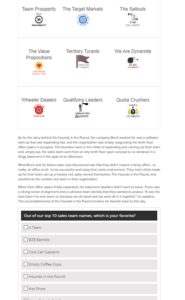
As we go through each individual page, we take mental note. We get more particular about comparing pages given this singular key term and situation.

Conclusion
In the end, we made sound suggestions backed by informed logic and strategy. The story ends well, for the page has been ranking for over five years. However, I wanted to devote this post to the process, which has been duplicated with success. I wish you success in targeting your own informational search queries.
Read More Muse:

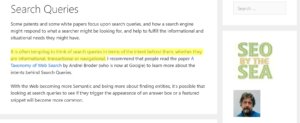
Leave a Reply
Want to join the discussion?Feel free to contribute!